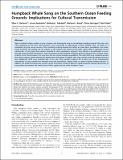Files in this item
Humpback whale song on the southern ocean feeding grounds : implications for cultural transmission
Item metadata
| dc.contributor.author | Garland, Ellen C. | |
| dc.contributor.author | Gedamke, Jason | |
| dc.contributor.author | Rekdahl, Melinda L. | |
| dc.contributor.author | Noad, Michael J. | |
| dc.contributor.author | Garrigue, Claire | |
| dc.contributor.author | Gales, Nick | |
| dc.date.accessioned | 2015-03-13T12:01:05Z | |
| dc.date.available | 2015-03-13T12:01:05Z | |
| dc.date.issued | 2013-11-20 | |
| dc.identifier | 174254698 | |
| dc.identifier | 1017388d-3b3c-4124-9d91-9ebe9a5ff4e4 | |
| dc.identifier | 000327313100021 | |
| dc.identifier | 84894244174 | |
| dc.identifier.citation | Garland , E C , Gedamke , J , Rekdahl , M L , Noad , M J , Garrigue , C & Gales , N 2013 , ' Humpback whale song on the southern ocean feeding grounds : implications for cultural transmission ' , PLoS One , vol. 8 , no. 11 , 79422 . https://doi.org/10.1371/journal.pone.0079422 | en |
| dc.identifier.issn | 1932-6203 | |
| dc.identifier.other | ORCID: /0000-0002-8240-1267/work/49580218 | |
| dc.identifier.uri | https://hdl.handle.net/10023/6222 | |
| dc.description | Date of Acceptance: 23/09/2013 | en |
| dc.description.abstract | Male humpback whales produce a long, complex, and stereotyped song on low-latitude breeding grounds; they also sing while migrating to and from these locations, and occasionally in high-latitude summer feeding areas. All males in a population sing the current version of the constantly evolving display and, within an ocean basin, populations sing similar songs; however, this sharing can be complex. In the western and central South Pacific region there is repeated cultural transmission of song types from eastern Australia to other populations eastward. Song sharing is hypothesized to occur through several possible mechanisms. Here, we present the first example of feeding ground song from the Southern Ocean Antarctic Area V and compare it to song from the two closest breeding populations. The early 2010 song contained at least four distinct themes; these matched four themes from the eastern Australian 2009 song, and the same four themes from the New Caledonian 2010 song recorded later in the year. This provides evidence for at least one of the hypothesized mechanisms of song transmission between these two populations, singing while on shared summer feeding grounds. In addition, the feeding grounds may provide a point of acoustic contact to allow the rapid horizontal cultural transmission of song within the western and central South Pacific region and the wider Southern Ocean. | |
| dc.format.extent | 9 | |
| dc.format.extent | 4734745 | |
| dc.language.iso | eng | |
| dc.relation.ispartof | PLoS One | en |
| dc.subject | Eastern North Pacific | en |
| dc.subject | Megaptera-novaeangliae | en |
| dc.subject | Population-structure | en |
| dc.subject | Acoustic detections | en |
| dc.subject | Wintering grounds | en |
| dc.subject | Atlantic-ocean | en |
| dc.subject | Zealand waters | en |
| dc.subject | New-Caledonia | en |
| dc.subject | Basic scale | en |
| dc.subject | Migration | en |
| dc.subject | QH301 Biology | en |
| dc.subject.lcc | QH301 | en |
| dc.title | Humpback whale song on the southern ocean feeding grounds : implications for cultural transmission | en |
| dc.type | Journal article | en |
| dc.contributor.institution | University of St Andrews. School of Biology | en |
| dc.contributor.institution | University of St Andrews. Sea Mammal Research Unit | en |
| dc.contributor.institution | University of St Andrews. Centre for Social Learning & Cognitive Evolution | en |
| dc.contributor.institution | University of St Andrews. Centre for Biological Diversity | en |
| dc.identifier.doi | 10.1371/journal.pone.0079422 | |
| dc.description.status | Peer reviewed | en |
This item appears in the following Collection(s)
Items in the St Andrews Research Repository are protected by copyright, with all rights reserved, unless otherwise indicated.

